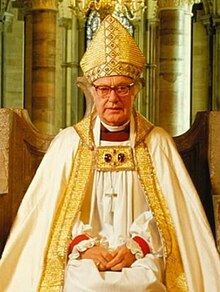The Lord Runcie | |
|---|---|
| Archbishop of Canterbury | |
 | |
| Church | Church of England |
| Province | Canterbury |
| Diocese | Canterbury |
| Installed | 25 March 1980 |
| Term ended | 31 January 1991 |
| Predecessor | Donald Coggan |
| Successor | George Carey |
| Other post(s) | Primate of All England |
| Previous post(s) | Bishop of St Albans (1970–1980) |
| Orders | |
| Ordination | 24 December 1950 (deacon) December 1951 (priest) by Noel Hudson |
| Consecration | 24 February 1970 by Michael Ramsey |
| Personal details | |
| Born | Robert Alexander Kennedy Runcie 2 October 1921 Birkenhead, England |
| Died | 11 July 2000 (aged 78) St Albans, Hertfordshire, England |
| Buried | St Albans Cathedral |
| Nationality | British |
| Denomination | Anglican |
| Spouse | |
| Children | 2, including James Runcie |
| Alma mater | |
| Signature | |
Robert Alexander Kennedy Runcie, Baron Runcie, MC, PC (2 October 1921 – 11 July 2000) was an English Anglican bishop. He was the Archbishop of Canterbury from 1980 to 1991, having previously been Bishop of St Albans. He travelled the world widely to spread ecumenicism and worked to foster relations with both Protestant and Catholic churches across Europe. He was a leader of the Liberal Anglo-Catholicism movement. He came under attack for expressing compassion towards bereaved Argentines after the Falklands War of 1982, and generated controversy by supporting women's ordination.[1][2]
Biographer Adrian Hastings argues that Runcie was not a distinguished writer or thinker, but was a good administrator who made shrewd appointments, demanded quality, and recognised good performances.[3]
- ^ John Cannon, The Oxford companion to British history (2002), p. 826.
- ^ "Archbishop of Canterbury's letter to Cardinal Willebrands on ordination to the priesthood". IARCCUM.org. 22 November 1985. Retrieved 3 June 2023.
- ^ Adrian Hastings, Robert Runcie (Continuum, 1991).